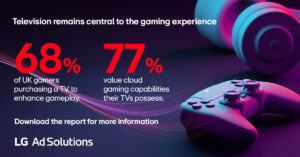MiQ’s Strategy Director, Pierre de Lannoy and EssenceMediacom’s AV Account Director, Bhavana Pillarisetti discuss the latest challenges of the CTV landscape…
What are the challenges you’re seeing right now when it comes to the connected TV (CTV) space?
BP: A key challenge we face with CTV is the vast level of fragmentation, which has provided the viewer with more choice across a range of platforms, devices, and formats, but in turn has increased the complexity for advertisers. Gone are the days where you can only use linear TV to deliver dependable returns at scale, we now have to navigate the changes in consumption to future-proof our clients’ campaigns.
Another challenge we face is measurement. Certain suppliers are often planned and bought in silos, which can result in real challenges when it comes to cross-channel measurement. This leaves the onus on the agency to bring together cross-channel campaign learnings in order to gain valuable insight, but it’s something we have made huge improvements on at EssenceMediacom. A key part of this process has been determining the right partners which we have done so, internally and via third parties, and as a result we have navigated the issues presented by the walled gardens to deliver a more unified form of measurement.
PL: Fragmentation can be a double-edged sword when it comes to digital advertising. For example, we see younger generations showing preference for video-on-demand over traditional linear TV. But on the flip side, without a solid grasp on the supply landscape and robust measurement, it’s difficult to take advantage of this newfound targetability and efficiency.
At MiQ, we have approached this in a top-down approach – our CTV offering can complement linear TV by avoiding the inherent inefficiency of dealing with siloed publishers. While linear TV viewership remains the backbone of big screen awareness, consumer habits and behaviours are changing. And this means that marketers need to adapt their strategies. For our clients with a linear TV presence, we leverage our ACR partnership with Samba TV to identify under-exposed audiences on a geo-contextual basis, so advertisers can maximise their returns on their CTV investment. In addition, we utilise several offline and online datasets to bring holistic audience planning and insights using BARB, historical insights and census data (to name a few). And with third-party measurement, we now have the ability to prove incrementality where applicable.
How are you and your team finding solutions to solve these challenges?
BP: Across our brand campaigns we are now implementing a holistic OneAV approach to planning, which brings our specialisms together to maximise returns for clients across all video partners and formats available. It requires a separation from best practice planning in platform, to best practice across platforms. Using an extensive databank of knowledge, this approach marries effectiveness data with an understanding of how individuals interact with different forms of video, ensuring we don’t stray too far from what has worked historically, but leave ourselves room to optimise for changes in consumption.
OneAV is EssenceMediacom’s answer to the proliferation of video consumption. It’s a planning process that uses historical effectiveness data to ensure we don’t stray too far from what has worked in the past, how an individual interacts with a video placement and if that aligns with the creative, before landing on the correct blend of suppliers to maximise effective reach. Sounds complex? That’s because it is. However, we have distilled the different methods of buying video and corresponding metrics into one single currency, which helps clients to understand the true value of each supplier, with overall predicted reach and outcomes.
PL: At MiQ, we’ve built a pro-marketer CTV product that empowers brands and agencies to achieve omnichannel campaigns that drive results, no matter the changing landscape. From a planning perspective, ACR and BARB data we utilise allows us to provide advertisers with robust TV audience viewing insights from a combination of traditional gold standard TV datasets, coupled with digital focussed datasets. This enables us to bridge the gap by using offline TV data to fuel our online CTV buy. We have just launched an additional iteration to our TV planning tool – allowing for advertisers to see predicted reach of an audience across multiple video platforms.
As for measurement, the incremental reach analysis we run provides our clients with data on the incremental households MiQ activity has reached on top of their linear TV buy. From this, we can help the agency inform their future planning by demonstrating the cost efficiency of reaching a certain percentage of incremental users on CTV on top of linear TV.
How are you looking to include new channels like AVOD within your media campaigns?
BP: We currently have a portion of our campaigns that run across AVOD, and it is definitely a growing space – no doubt a partial result of SVOD suppliers raising the costs of their proposition. However, AVOD contributes to a lower level of ad-funded inventory when compared to traditional broadcasters such as ITV, C4 and Sky, as well as platforms such as YouTube. This brings the challenge of controlling frequency, as each platform is likely to see most of their viewing consumed by a smaller number of heavy viewers. AVOD offers a strong opportunity, but one that currently requires an approach that allows control of frequency at a holistic level.
PL: As Bhavana has noted, AVOD is a nascent and growing space. For MiQ, AVOD/FAST opens up a huge opportunity for UK marketers and is an increasingly large part of our business as we help marketers make sense of this complex space. Ultimately, broadcasters are, and continue to be, the first port of call for mass reach on the big screen and continue to have unrivalled scale.
That being said, there is a point of diminishing returns where the cost per incremental unique impact offered outside the traditional broadcasters can’t be ignored. We’ve seen great success in using AVOD platforms such as YouTube to target younger demographics and alongside long tail publishers/apps to reach cord cutters – a complementary strategy to linear TV advertising. We are seeing this trend continue and audiences grow as more of the UK population discover their favourite content is available for free on AVOD platforms. This is all underpinned by the cost-of-living crisis, which is pushing UK residents to save in streaming subscription costs by turning to free streaming services.
Buying linear TV isn’t getting any cheaper – how are you looking to ensure that you’re buying big screen TV and reaching audiences in the most cost-effective way?
BP: Although TV is subject to cost inflation, coupled with impact on reach potential, particularly for younger audiences, it remains the largest driver of business effects for the vast majority of advertisers. Due to this, it continues to be the foundation of most media plans. However, this represents just part of the narrative. Agencies and brands need to build on traditional thinking on how to bridge the gap where TV falls short; we should also be looking at the effectiveness of the media channel and how that has changed over time. This is why we look to plan effective reach – reach that will deliver outcomes.
Media specialists must consider the quality of reach, asking themselves if it will help to build memory structures, shift awareness, and get brands onto the consumers’ mental shortlist. This is where planners need to move beyond looking at a surface metric like impression-based reach, structuring their approach around delivering outcomes for clients. Overall, when it comes to being cost-effective, it is important to find the right balance across multiple video formats with these considerations in mind. Although it might go against traditional thinking in some instances, it will ensure no brand is left behind in this digital age.
PL: As a managed service provider, we’ve positioned ourselves to complement our partners’ linear TV activity in the most cost-effective way; we’re doing this through bespoke solutions and products. As mentioned, the major benefit of CTV is reduced cost-per-cover especially when a campaign is reaching its saturation point. This benefit becomes even more important when going after particular audiences i.e younger demographics and special interests. To reduce wastage when spending on top of a linear TV campaign, MiQ have built a reach extension planner where we can advise our partners on where to reach their audience and what platforms and apps to use.
A big focus for us is proving the value of CTV reach. Firstly, by utilising measurement partners to show we have reached the intended audience, but also through brand lift studies and attention measurement. With so many partners to choose from and multiple ways to buy the same inventory you must invest time and money to optimise the delicate balance of price and outcomes.









